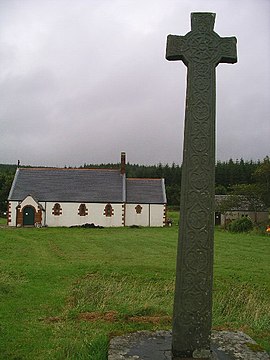Morvern
Morvern
|
|
|---|---|
 Kiel Church and the Morvern Cross, at Lochaline; Kiel is derived from Cille Choluimchille, church of Saint Columba |
|
| Morvern shown within the Lochaber area | |
| Population | 320 |
| • Edinburgh | 190 miles (road) 149 miles (via Corran ferry) |
| • London | 567 miles (road) 526 miles (via Corran ferry) |
| Council area | |
| Lieutenancy area | |
| Country | Scotland |
| Sovereign state | United Kingdom |
| Post town | OBAN |
| Postcode district | PA80 |
| Dialling code | 01967 |
| Police | Scottish |
| Fire | Scottish |
| Ambulance | Scottish |
| EU Parliament | Scotland |
| UK Parliament | |
| Scottish Parliament | |
Morvern, historically also spelt Morven, is a peninsula and traditional district in the Highlands, on the west coast of Scotland. It lies south of the districts of Ardgour and Sunart, and is bounded on the north by Loch Sunart and Glen Tarbert, on the south east by Loch Linnhe and on the south west by the Sound of Mull. The name is derived from the Gaelic A' Mhorbhairne (the Sea-Gap). The highest point is the summit of the Corbett Creach Bheinn which reaches 853 metres (2,799 ft) in elevation.
Administratively Morvern is now part of the ward management area of Lochaber, in Highland council area. It forms part of the traditional shire and current registration county of Argyll.
Morvern is approximately 250 square miles (650 km2) with a current population of about 320.
Morvern was formerly known as Kinelvadon, which William J. Watson takes to be from Cineal Bhaodain, that is that lands of the Cenél Báetáin, a division of the Cenél Loairn named after Báetán, a putative great-grandson of Loarn mac Eirc. The Senchus fer n-Alban states that "Baotan has twenty houses".
The ruined Ardtornish Castle was in the possession of Somerled in the 12th century and then the Lords of the Isles, whose ownership was recalled in a poem of the same name by Sir Walter Scott. Kinlochaline Castle was once the seat of the MacInnes clan. It was largely destroyed by the army of Oliver Cromwell and restored in 1890.
...
Wikipedia

